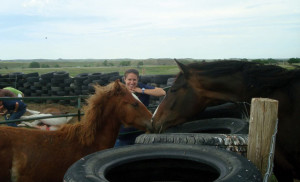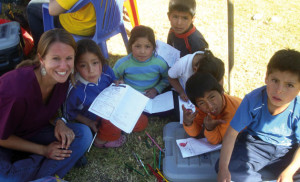Gebhart uses degrees to fulfill passion of caring for horses

Angie Gebhart has a passion, and thanks to a Spanish degree and an equine minor from SDSU in May 2012, she is using that education to make a difference by immersing herself in the health care of horses.
Passion is defined as having a strong liking, desire or devotion to some activity, object or concept.
Angie Gebhart has a passion, and thanks to a Spanish degree and an equine minor from SDSU in May 2012, she is using that education to make a difference by immersing herself in the health care of horses.
A high school and middle school Spanish teacher in Waconia, Minn., Gebhart needed an internship as required in the equine minor so she approached assistant professor and equine specialist Rebecca Bott about going to Mexico.
“I said if your parents are comfortable with it, I’m comfortable at making this work because you’re doing some phenomenal things for horses and you will obviously be learning a tremendous amount,†recalls Bott, who has a three-way teaching, research and Extension appointment in the department of animal science.
In October 2010 Gebhart accompanied a group of veterinarians for a one-week stay in Veracruz, Mexico, under the umbrella of the American Association of Equine Practitioners.
Their mission was educational in nature with the veterinarians helping the locals in providing better equine care to the animals and training to
their owners.
Gebhart’s role was mainly serving as a translator for the vets at the sites where horses were being tested. She also met with owners to discuss their horse-related problems.
A passion to pursue
“The days were long and the week went by fast,†says Gebhart, a four-year letterwinner on the Jackrabbit equestrian team, who came back from Mexico completely invigorated and focused on what she wanted to do next.
“It was my eureka moment. I realized what I wanted to do with my life, because all my life I’ve been a horse crazy kid,†says Gebhart, whose experience in Mexico evolved into what she terms as the equitarian initiative.

Gebhart developed a color book that was given to the youth on the Pine Ridge and Cheyenne River reservations in summer 2012 as well as youth in Mexico during an equitarian workshop in fall 2011.
“Veterinarians, students and horse lovers alike want to improve the well-being of horses, donkeys and mules who are down on their luck,†she says. “Whose heart doesn’t break when you see the long ears and humble attitude of a downtrodden donkey?â€
The Maple Grove, Minn., native points out that equitarian initiatives not only provide specialized aid from vets, they have also become humanitarian projects by nature because the initiative combines aspects of education, community empowerment and cultural exchanges to help people whose livelihoods depend on the animals.
“These animals are the farm trucks and school buses in many areas,†says Gebhart. “That’s why this initiative has become so near and dear to me.
“Not only do I get to feel like I’m in some way helping equines, the project also combines my love of learning about culture, teaching, getting kids involved and travel.â€
Honors College project
Since Gebhart was an Honors College student, she needed an honors research project to graduate — a project that would give her in-depth experience and mentorship in her area of passion.
Gebhart met with Bott and Honors College Dean Tim Nichols and discussed the idea of bringing the equine initiative to South Dakota. She decided to target the Cheyenne River Indian Reservation in Ziebach County, which, according to state census data, is the fourth poorest county in the nation based on per capita income.
“That was my independent research project,†says Gebhart, who with Bott received funding through the Honors College to survey all the equine practitioners in the state to get their perspective on health care for reservation horses.
Liking how the project was being received, Gebhart and Bott then traveled to the Cheyenne River Indian Reservation to conduct a health care and needs assessment on 300 horses in June 2011.
Bott said their five-day stay on the reservation was a success, especially due to Gebhart’s work prior to the trip.
“Angie was tremendous in taking the initiative to make all the necessary contacts and get in touch with the people we needed to visit,†she says. “She learned that we needed tribal council approval so we went down there and spoke and answered their questions.
“One of the main things on reservations is that there’s not always a veterinarian nearby to offer services for horse care due to long distances, so that’s an on-going challenge they are facing.â€
Research paper published
Returning to campus, Gebhart and Bott set about summarizing their findings for the research report. However, Gebhart’s dedication went a step further when they submitted the paper for publication in the Journal of Equine Veterinary Science. It was accepted and will be published in early 2013.
“Angie is a very talented writer who was able to blend the sociological and animal science components of the project,†recalls Bott. “She learned very quickly how to look up peer-reviewed articles and respectable journals to evaluate them for information.
“Honors students are asked to do an independent research project and present it, but her leadership and effort to go on to produce material for publication just blew me out of the water.â€
Gebhart reasons that the equitarian initiative is still relatively new and the more people who know about it the better.
“Publishing it in a journal that veterinarians read is another way to spread the word and invite other vets to become more involved with potentially underserved horse populations in South Dakota.â€
More equine training
Gebhart, though, wasn’t done with her initiative efforts, not by a long shot.
In October 2011 she and Bott returned to Mexico for a week to gather more ideas on equine care. They talked with people and surveyed community leaders, while assisting veterinarians with surgeries and dentistry on horses.
When they were at the Cheyenne River Indian Reservation in summer 2011, one of the prominent needs identified was hoof care.
From that information they put together a farrier apprenticeship educational program for the Pine Ridge Reservation, which was supported by a Beginning Farmer and Rancher Grant awarded to Shawn Burke of SDSU Extension. Pine Ridge was selected because it already had an established beginning farmer and rancher group—many of whom work with horses.
In June 2012 they traveled to Pine Ridge along with farrier instructors Mike Olson and Brooks Varnum. The two men taught a farrier apprenticeship course to nine individuals, who were selected from an application process.
In addition to farrier training, workshops and discussions on equine nutrition and health were offered to the general public as well as vaccinations and care to the horses.
Bott returned to Mexico in fall 2012, but this time it wasn’t with Gebhart, who had just started teaching in Waconia. Her absence was clearly noticeable.
“The vets and veterinary students from Mexico who had met her were all asking ‘How is Angie doing?’†says Bott, who continues to stay in touch with Gebhart.
“I learned so much from Angie that it quickly became a partnership. She has so much drive and ambition. She has already accomplished so many things that people would be proud of in a lifetime.
“Angie is still brainstorming in helping us out with creative ideas for the work we do in South Dakota and on the reservations. Even though she is physically done with her work here, she’s still very much part of the equine initiative.â€
Kyle Johnson






